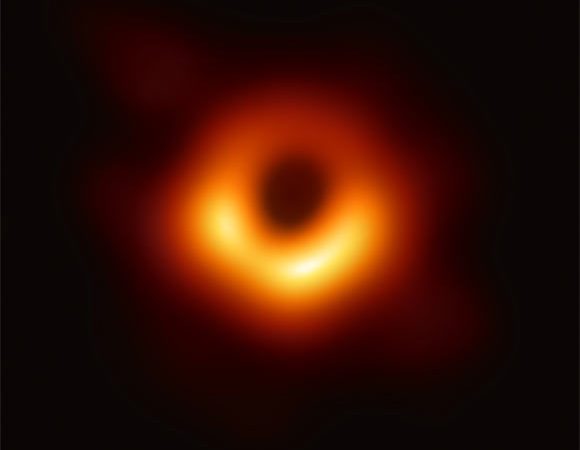In 2019, the Event Horizon Telescope (EHT) delivered the first resolved images of M87*, the supermassive black hole in the center of the giant elliptical galaxy Messier 87 (M87). Those images were produced using EHT observations performed in April 2017. Additional observations were required to investigate the persistence of the primary image feature and to quantify the image variability. To address this need, astronomers analyzed M87* data collected with the proto-EHT array of telescopes in 2009, 2011, 2012, and 2013. The analysis reveals the behavior of the black hole image across this period, indicating persistence of the crescent-like shadow feature, but also variation of its orientation — the crescent appears to be wobbling.
Source: Sci News
“EHT can detect changes in the M87* morphology on timescales as short as a few days, but its general geometry should be constant on long timescales,” said Dr. Maciek Wielgus, an astronomer at the Harvard & Smithsonian Center for Astrophysics.
“In 2019, we saw the shadow of a black hole for the first time, but we only saw images observed during a one-week window, which is too short to see a lot of changes.”
Combining proto-EHT data from 2009-2013 with data leading up to 2019 revealed that M87* adheres to theoretical predictions.
The shape of the black hole’s shadow has remained consistent, and its diameter remains in agreement with Einstein’s theory of general relativity for a black hole of 6.5-billion solar masses.
“In this study, we show that the general morphology, or presence of an asymmetric ring, most likely persists on timescales of several years,” said Dr. Kazu Akiyama, an astronomer at the MIT Haystack Observatory.
“This is an important confirmation of theoretical expectations as the consistency throughout multiple observational epochs gives us more confidence than ever about the nature of M87* and the origin of the shadow.”
Snapshots of the M87* supermassive black hole appearance, obtained through imaging and geometric modeling, and the EHT array of telescopes in 2009-2017. The diameter of all rings is similar, but the location of the bright side varies. Image credit: M. Wielgus, D. Pesce & EHT Collaboration.
While the crescent diameter remained consistent, the new data also prove it was hiding a surprise: the ring is wobbling.
The gas falling onto a black hole heats up to billions of degrees, ionizes and becomes turbulent in the presence of magnetic fields. This turbulence causes the appearance of the black hole to vary over time.
“Because the flow of matter falling onto a black hole is turbulent, we can see that the ring wobbles with time,” Dr. Wielgus said.
“The dynamics of this wobbling will allow us to constrain the accretion flow.”
“The accretion flow contains matter that gets close enough to the black hole to allow us to observe the effects of strong gravity, and in some circumstances, allows us to test predictions from general relativity, like we’ve done in this study,” said Dr. Richard Anantua, an astronomer at the Harvard & Smithsonian Center for Astrophysics.
Multiple years of ETH data allow the scientists to perceive the amount of variability in the ring’s appearance.
“Actually, we see quite a lot of variation there, and not all theoretical models of accretion flow allow for this much variability,” Dr. Wielgus said.
“As we obtain more measurements in the future, we will be able to confidently put constraints on models and rule some of them out.” https://www.dailymotion.com/embed/video/x7wejfs
In the current study, the team used data from the proto-EHT, an array that included telescopes at three geographical locations: the Combined Array for Research in Millimeter-wave Astronomy in Cedar Flat, California; the Submillimeter Telescope on Mt. Graham in Arizona; and the Submillimeter Array, the James Clerk Maxwell Telescope and the Caltech Submillimeter Observatory on Maunakea in Hawai’i.
“These early EHT experiments provide us with a treasure trove of long-term observations that the current EHT, even with its remarkable imaging capability, cannot match,” said Dr. Shep Doeleman, Founding Director of EHT.
“When we first measured the size of Messier 87 in 2009, we couldn’t have foreseen that it would give us the first glimpse of black hole dynamics.”
“If you want to see a black hole evolve over a decade, there is no substitute for having a decade of data.”
“The continued analysis of past observations, along with new observations, will lead to a better understanding of the dynamical properties of M87*, and black holes in general,” Dr. Wielgus said.
“Monitoring M87* with an expanded EHT array will provide new images and much richer data sets to study the turbulent dynamics,” said Dr. Geoffrey Bower, an astronomer at the Academia Sinica Institute of Astronomy and Astrophysics.
“We are already working on analyzing the data from 2018 observations, obtained with an additional telescope located in Greenland.”
“In 2021 we are planning observations with two more sites, providing extraordinary imaging quality. This is a really exciting time to study black holes!”
The team’s results were published in the Astrophysical Journal.
Source: Sci News

































Leave a Comment
You must be logged in to post a comment.